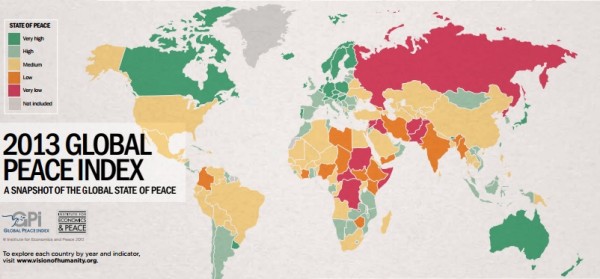No, not number one in military spending (which we are). Not number one in incarceration rates (which we are as well). What if, instead of these things, the U.S. became hyper-focused on becoming the most peaceful nation on earth?
The recently released 2013 Global Peace Index (GPI) placed the U.S.100th out of 162 countries. That’s not so spectacular. The GPI, which is endorsed by a number of Nobel Peace laureates, eminent individuals, and renowned academics, considers factors related to both negative peace, that is, the absence of violent conflict, and positive peace, or characteristics of just and humane societies, like ample housing, access to education, lack of poverty, healthcare, and gender equality. The GPI’s Positive Peace Index measures attitudes, institutions and structures that either promote or prohibit a peaceful environment.
The 2013 GPI noted that, since the 2008, 110 countries have become less peaceful. The U.S is one of these. The U.S scores particularly poorly in regards to its high prison and jail population, its large and active military, the number of conflicts it is engaged in overseas and the number of combat deaths, its heavy weapons capacity and ease of access to small arms. The U.S. rates moderately on measures related to gender equality, education, and infant mortality.
This failure to commit to peace is a global catastrophe, and a costly one at that. The GPI report, available at www.visionofhumanity.org, calculates the total economic impact of containing violence to have been $9.46 trillion in 2012. According to the report, cutting the cost of violence in half would be enough to repay all the debts of the developing world, provide for European financial stability, and fully fund the Millennium Development Goals.
So, what does it take to get to the top, to be a “peace” country? The top ten of the GPI is dominated by small Nordic countries, although New Zealand, Canada and Japan are included as well. Despite being far different geographically and in its population, the U.S can perhaps draw a thing or two from these countries. Difficult economic times notwithstanding, Iceland is number one for its low crime rates, its minimal military, and its resistance to getting involved in global violent conflict. In general, the high peace countries tend to have, among other qualities, more equitable distribution of resources, greater trust between citizens, and more social cohesion. They invest in health and education and seek alternatives to retributive justice. In essence, nations that score high on positive peace tend also to be high on the overall GPI.
Perhaps the most important goal for the U.S. is to reduce the size, expenditure, and use of its military. It is this militarism that is the underlying cause of the country’s poor ranking. Yet 57% of President Obama’s proposed 2014 budget is devoted to military. Not a step in the right direction. All the more reason, however, for anyone who wants peace to remain vocal and vigilant. How about if we try to be number one at something else for a change.
~~~~~~~~~~~~“
Laura Finley, Ph.D., teaches in the Barry University Department of Sociology & Criminology and is syndicated by PeaceVoice.
The original article can be found on the PeaceVoice website, here.






